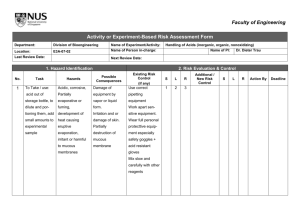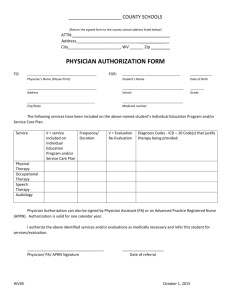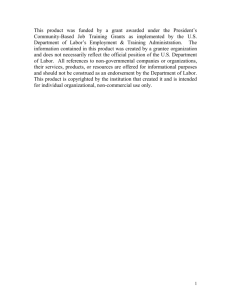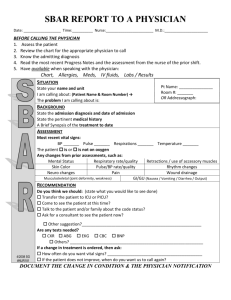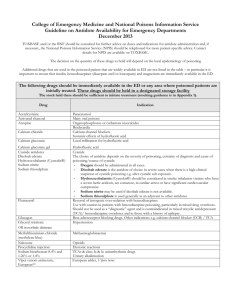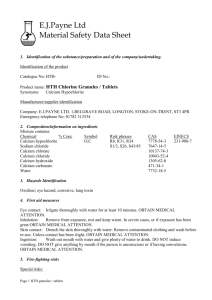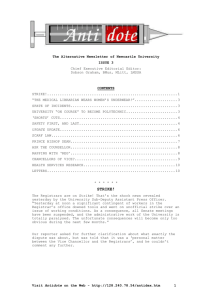HF etching solution - Department of Biomedical Engineering
advertisement
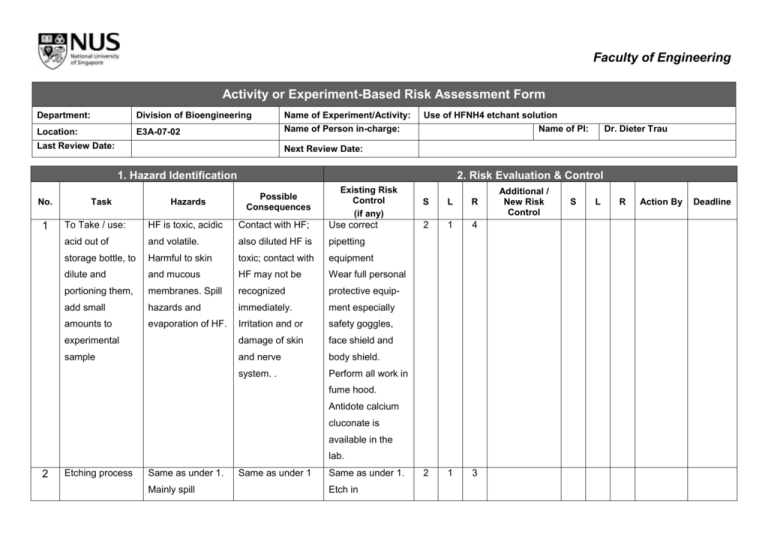
Faculty of Engineering Activity or Experiment-Based Risk Assessment Form Department: Division of Bioengineering Name of Experiment/Activity: Location: E3A-07-02 Name of Person in-charge: Last Review Date: Use of HFNH4 etchant solution Name of PI: Next Review Date: 1. Hazard Identification No. 1 Task Hazards 2. Risk Evaluation & Control Possible Consequences Existing Risk Control (if any) To Take / use: HF is toxic, acidic Contact with HF; Use correct acid out of and volatile. also diluted HF is pipetting storage bottle, to Harmful to skin toxic; contact with equipment dilute and and mucous HF may not be Wear full personal portioning them, membranes. Spill recognized protective equip- add small hazards and immediately. ment especially amounts to evaporation of HF. Irritation and or safety goggles, experimental damage of skin face shield and sample and nerve body shield. system. . Perform all work in S L R 2 1 4 2 1 3 fume hood. Antidote calcium cluconate is available in the lab. 2 Dr. Dieter Trau Etching process Same as under 1. Mainly spill Same as under 1 Same as under 1. Etch in Additional / New Risk Control S L R Action By Deadline hazards. Wash polypropylene etched substrate closed box. carefully before Antidote calcium removing from cluconate is etching area. available in the lab. 3 Disposal of HF Acidic, corrosive, Spill and vapor. Mix slow and Partially carefully with other evaporative or reagents if fuming, necessary. development of Dispose only in heat causing designated bottles eruptive for HF. Dilute HF evaporation, and dispose into irritant or harmful calcium chloride to mucous solution to form membranes harmless Calcium Might react with fluoride. Antidote other substances, calcium cluconate be dangerous to is available in the environment lab. 2 1 4 First Aid Measures Inhalation: If inhaled, remove to fresh air. If not breathing, give artificial respiration. If breathing is difficult, give oxygen. CALL A PHYSICIAN IMMEDIATELY. Ingestion: Administer milk, chewable calcium carbonate tablets or milk of magnesia. Never give anything by mouth to an unconscious person. CALL A PHYSICIAN IMMEDIATELY. Skin Contact: Wipe off any excess material from skin and then immediately flush skin with large amounts of soapy water. Remove contaminated clothing and shoes. Wash clothing before re-use. Apply bandages soaked in magnesium sulfate. CALL A PHYSICIAN IMMEDIATELY. Eye Contact: Immediately flush eyes with gentle but large stream of water for at least 15 minutes, lifting lower and upper eyelids occasionally. Call a physician immediately. Note to Physician: For large exposures, systemic effects (hypocalcemia and hypomagnesia) may occur. Conducted by: (Name, designation) Dieter Trau Signature: Date: Approved by: (Name, designation) Signature: March 2010 Date: Dr. Dieter Trau Risk Assessment Matrix Likelihood Severity Minor Moderate Major Remote (1) Occasional (2) Frequent (3) 1 2 3 2 4 6 3 6 9 (1) (2) (3) Severity Categories Level Human (Impact to Physical Being) Biological Impact Environmental Damage Property Damage (S$) (1) Minor No Injury or light injury requiring only first aid treatment (MC < 4 days MC) Any injury/ill health leading to ≥ 4 days MC or ≥ 1 day hospitalisation or leads to temporary disability May not cause human disease, if does, the disease is unlikely to spread to the community and there is usually effective prophylaxis or treatment available; Reversible Up to $5,000 Can cause severe human disease, not ordinarily spread by casual contact from one individual to another; it may spread to the community, but there is usually effective prophylaxis or treatment available Reversible but takes years $5,001 to $50,000 Fatality, permanent Disability or life threatening disease Can cause lethal human disease, may be readily transmitted from one individual to another, or from animal to human or vice-versa directly or indirectly, or casual contact, it may spread to the community; usually no effective prophylaxis or treatment available Irreversible More than $50,000 (2) Moderate (3) Major Likelihood Categories Level (1) Remote (2) Possible (3) Frequent Events Frequency Undesired event which may occur but unlikely, once in 5 years Undesired event which is probable, once in a year Undesired event which probably occur in most circumstances, once or more in a month Risk Level and Acceptability Criteria Risk Score Risk Level Acceptability of Risk <3 Low Risk Acceptable Medium Risk Moderately Acceptable 3–4 Recommended Actions No additional risk control measures required. To continue to monitor to ensure risk do not escalate to higher level. Acceptable to carry out the work activity; however, task need to be reviewed to bring risk level to As Low As Reasonably Practicable. Interim control measures such as administrative controls can be implemented. Supervisory oversight required. Job must not be carried out until risk level is brought to at least medium risk level. >4 High Risk Not Acceptable Risk controls should not be overly dependant on personal protective equipment. Controls measures should focus on Elimination, substitution and engineering controls. Immediate Management intervention required to ensure risk being brought down to at least medium level before work can be commenced.
